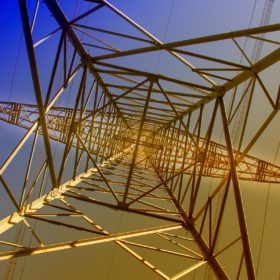
Batteries of the type have traditionally been used for long-duration storage applications. Now though, it seems vanadium is making an entry into the fast-paced world of ancillary grid services.
With investments in intermittent renewable energy resources on the rise in the U.K., the need for storage solutions is rising in tandem. While lithium-ion battery cells remain the go-to solution, alternative technologies continue to gain traction amid concerns over the social and environmental ramifications of lithium and technical limitations of the technology.
Energy storage infrastructure company redT has secured access for its vanadium-flow battery to the U.K.’s ancillary grid services market. The company says the development – approved by electricity system operator National Grid – marks the first time such a battery has been pre-qualified for dynamic firm-frequency response (dFFR) services to the U.K. network.
RedT has placed a 60 kW/300 kWh flow battery with a 250 kW solar array next to an industrial site in Dorset in the southwest of England. Open Energi has supplied its Dynamic Demand 2.0 energy optimization platform, which uses artificial intelligence to maximize savings and optimize revenues. The partner companies claim the battery and solar system – plus the optimization software – enable a 33% cost reduction in the industrial client’s energy bill.
Flow battery longevity
Vanadium-flow batteries offer a higher cycling rate and more longevity than rival lithium-ion products. RedT says that increased service life makes vanadium a better option for applications with high levels of asset utilization, such as that characterized by revenue stacking and frequent daily operation.
RedT told pv magazine vanadium-flow batteries do not degrade so they have no cycling costs. Peter Fischer, of the Fraunhofer Institute for Chemical Technology, last year told pv magazine: “In a flow battery, electrical energy is stored in a liquid and not on electrode surfaces. As the electrochemical reaction takes place in the liquid the two electrodes don’t charge during the charging and discharging reaction.” He added, under ideal conditions such batteries will not degrade but in real world conditions they can face corrosion and electrolyte capacity can fade.
RedT said it believes its system has a service life of around 25 years. Last year, consultants at Apricum told pv magazine DC system capital expenditure for vanadium-flow batteries is high, at $190/kWh and $890/kW, under the assumption of a 20-year lifetime and with 0.4% annual degradation.
Dire storage needs
“As the U.K. continues to prioritize investment in renewable energy it will require a broad suite of technologies to balance the grid effectively and harness additional flexible capacity,” said Open Energi director David Hill. “The partnership between redT and Open Energi provides tangible evidence of the vital and important role cutting edge technologies will play in achieving a 100% renewable grid.”
Flow batteries had previously been dismissed for fast response grid service applications with network operators instead focusing on their extended-duration capability. That was down to a misconception, according to redT chief executive Scott McGregor. “With the help of Open Energi and their impressive Dynamic Demand 2.0 platform, we have been able to prove that our flow machines can provide a full range of services with no marginal degradation cost per cycle, making them a viable and economically attractive alternative to traditional lithium-ion systems,” he said.
The CEO also underscored new, non-degrading, heavy cycling energy storage technologies held the potential to provide flexibility which is much needed for a net-zero carbon emission future, which the U.K. government has pledged to achieve by 2050.
“This is a key opportunity for investors, energy managers and business owners to deploy 25-year energy storage infrastructure at their sites,” added McGregor, “an essential piece of the puzzle our country must solve in order to achieve net-zero by 2050.”
Lắp đặt điện mặt trời Khải Minh Tech
https://ift.tt/2X7bF6x
0906633505
info.khaiminhtech@gmail.com
80/39 Trần Quang Diệu, Phường 14, Quận 3
Lắp đặt điện mặt trời Khải Minh Tech
https://ift.tt/2ZH4TRU
Không có nhận xét nào:
Đăng nhận xét